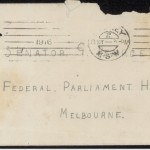Opposing Conscription
Industrial Workers of the WorldThis webpage was developed as part of State Archives’ contribution to History Week 2015.
One of the most vocal and radical campaigns against conscription came from the Industrial Workers of the World (IWW), also known as ‘The Wobblies’. The IWW is a labor union that believes in the concept of the ‘one big union’, where the working class are united against the exploitation of capitalists and the profit system is abolished. (1)
The IWW constantly pushed the boundaries of free speech, often ending up in gaol as they refused to pay fines on principle. (2) Using their own printing press, they produced and distributed the newspaper Direct Action. With headlines such as ‘War? What For?’ and ‘One Enemy – the Employing Class’, they employed a ‘no holds barred’ approach to commentary on the war, the government, and conscription, restrained only by the government
censor. (3)
Both the State and Commonwealth governments regarded the IWW as a major threat, with the Prime Minister calling them ‘anarchists’ and ‘enemies of society’ who ‘must be fought with the ferocity of a Bengal tiger’. (4) Twelve IWW members were tried and imprisoned just before the first plebiscite on charges of sedition, arson and forgery, in what was seen by many to be a political strategy to silence the organisation. Most of them were later released after a Royal Commission into the trial. (5) The IWW were also implicated as the possible source of anonymous death threats which were sent to Acting Prime Minister Pearce (who was also the Minister for Defence) in May 1916, however the New South Wales police could find no evidence of such a link. (6)
- [Fig. 2] Death threat. From NRS 905 [5/7439 letter 16/37674].
- [Fig. 3] Death threat envelope. From NRS 905 [5/7439 letter 16/37674].
Much to the dismay of Hughes and Holman, the IWW continued to operate. However, Hughes increased the pressure on the organisation by introducing the Unlawful Associations Act, which named the IWW as an unlawful association and imposed a six month prison sentence on anyone associating with the organisation. (7) Many members were imprisoned as a result and some of the key players were then deported. (8) In addition, the War Precautions Act was also amended to prevent circulation of ‘Direct Action’. These measures combined to seal the nail in the coffin of the Sydney branch of the IWW.
Related
References
(1) Industrial Workers of the World. (n.d). Industrial Workers of the World – What Everyone Should Know, http://www.iww.org/culture/official/qanda, (accessed on 18 August 2015).
(2) Barker, Tom & Fry, Tom Barker and the I.W.W., Australian Society for the Study of Labour History, Canberra, 1965, p. 19.
(3) Beattie, Bill. ‘Memoirs of the I.W.W.’ Labour History, 13 (1967): 33-39, https://libcom.org/files/Memoirs%20of%20the%20I.W.W.pdf, (accessed 3 August 2015); Direct Action (10 August 1914). Issue No. 11, http://www.jura.org.au/files/jura/DirectAction-No11-10Aug1914_0.pdf.
(4) Commonwealth of Australia, House of Representatives. (25 July 1917). Parliamentary Debates (Official Hansard) – Unlawful Associations Bill – Speech – Hughes, William Morris, http://parlinfo.aph.gov.au/parlInfo/genpdf/hansard80/hansardr80/1917-07-25/0101/hansard_frag.pdf;fileType=application%2Fpdf, (accessed 3 August, 2015); ‘Mr Hughes on the War’, The Australian Worker, 20 January 1916, p. 18, http://nla.gov.au/nla.news-page16650649.
(5) State Archives New South Wales: Royal Commission on Inquiry into the matter of the trial and conviction and sentences imposed on Charles Reeve and others; NRS 1525, Printed report and minutes of evidence [4/7594]; Turner, Ian, Sydney’s Burning, London, Heinemann, 1969, pp. 204-211.
(6) SANSW: Colonial Secretary; NRS 905, Letters received [5/7439] 16/37674, Report from Detective 1st Class N Moore.
(7) Commonwealth of Australia, House of Representatives, 25 July 1917.
(8) SANSW: State Penitentiary, Long Bay; NRS 2464, Entrance books, 18 June 1918, No. 2247 Tom Barker; SANSW: Albury Gaol; NRS 1966, Photographic description books [3/5999] 31 August 1917, Arthur Wyer.

![[Fig. 1] Direct action logo. From NRS 905 [5/7442 letter 16/40328, p.2].](http://nswanzaccentenary.records.nsw.gov.au/wp-content/uploads/2015/09/Fig-8-NRS9055_7442-16_40328-Direct-Action-002-Logo-cropped-148x300.jpg)


